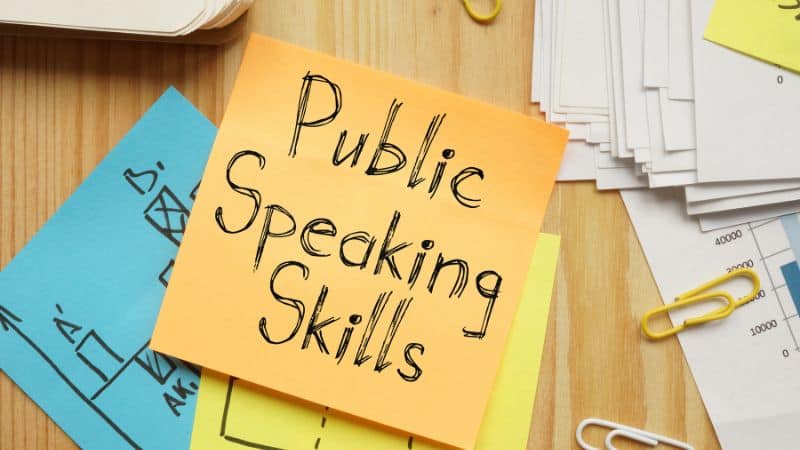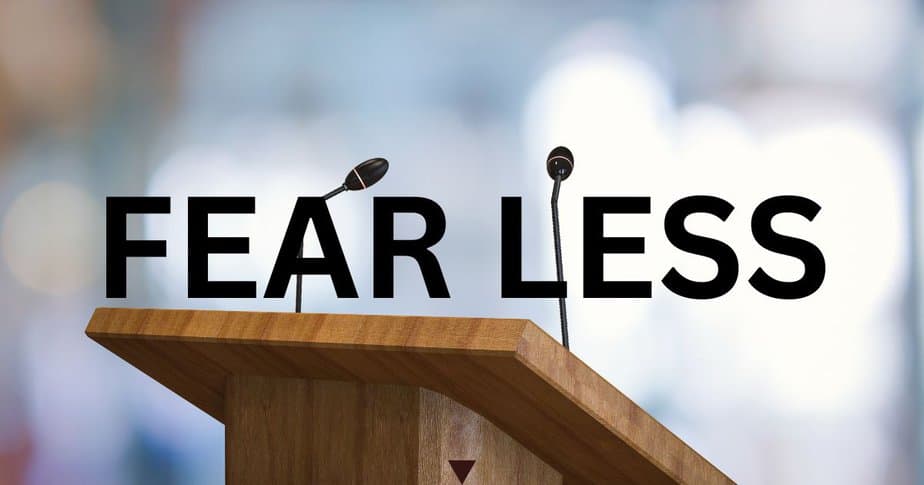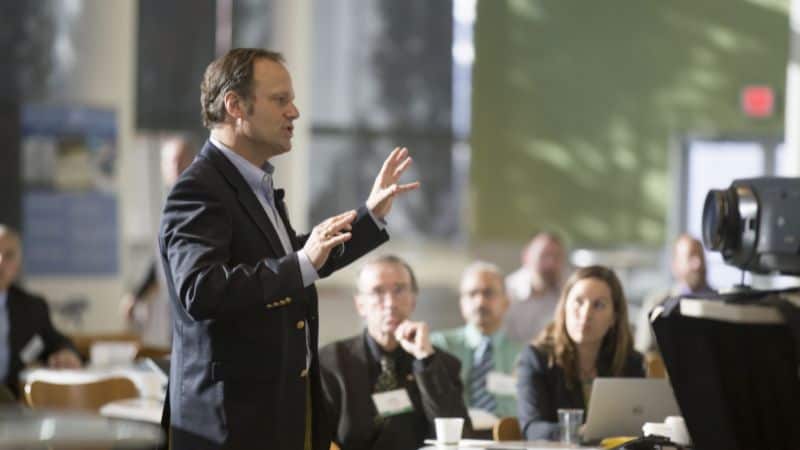Boost your public speaking skills. It makes your thoughts visible. Public speaking skills can amplify your roles as professionals, teachers, and leaders. there are easy and simple ways to become a confident and compelling public speaker.
Public speaking turned my life around. Having the courage to speak before a crowd gives people the opportunity to be heard, make their thoughts visible, and lead others. In a world where most people avoid public speaking opportunities, those who dare to stand up and deliver become the leaders.
Public Speaking Training
Public speaking training can help you build speaking skills. The public speaking courses that I designed serve specific purposes. There are courses for executives, managers, supervisors, and students. Find out how you can develop your speaking skills today.

Tips for Improving Public Speaking Skills
If you’ve been a student of public speaking, you will find many of the tips new to you. That’s because some popular public speaking tips, like imagining your audience naked, are impractical and ineffective.
Many books on public speaking, unfortunately, were written by authors who regurgitated bad ideas.
It is also common for speaking gurus to teach students how to become fearless speakers. Everyone seemed to desire that too. But it comes with a wrong understanding of public speaking. Speakers need to become confident; they don’t need to be fearless. Heroes are never fearless.
So, the first tip will correct this wrong teaching.
Tip 1: Rethink Your Goal – Fear Less, Not Fearless
Do you strive to be fearless in your public speaking endeavors?
Many books promise us a path to speaking fearlessness, a concept people buy into because it sounds like the ultimate goal. We’ve seen speakers who seem to exude confidence effortlessly and we aspire to be like them, associating their charisma with the absence of fear.
To gain speaking confidence. it’s essential to reframe this idea.
Absolute fearlessness is not only unrealistic, but it could even create a barrier between you and your audience.
Fear is an emotion, a shared human experience that can enable us to resonate more deeply with our listeners.
You don’t have to be fearless, aim to fear less.
Fear can actually serve as a motivation. Fear can inspire us to seek out creative ways to connect with our audience. Too much fear, on the other hand, can obstruct our vision, veering us away from our speech’s core purpose.
So, how can we fear less?
It’s simpler than you might think. Start by acknowledging your fears. Label them. Identify the benefits of addressing them. When they are very important, find ways to solve them. This identification process can significantly reduce their intensity.
Lastly, transform your relationship with fear. Instead of letting it dictate your reactions, be proactive. Address fear head-on.
Remember, the goal is to manage fear, not to eliminate it completely. This change in approach is the first step towards becoming a more confident speaker.
Great leadership isn’t an event—it’s a habit. Get actionable leadership habits every Monday and Thursday.
Tip 2: Embrace Nervousness – It’s Part of the Process
Nervousness is a natural response. We become nervous because that’s how our brain protected human beings since the very beginning. Our ancestors survived because of nervousness.
I will explain.
This nervousness originates from our brain’s instinct to protect us when we venture into unfamiliar territory. Our brain triggers a series of physiological responses designed for survival. It funnels our energy into the limbs we use most in combat situations – our arms and legs.
Our mouths dry up because eating isn’t a priority in public speaking.
Those infamous butterflies we feel in our stomachs are not exclusive to public speaking; they are our brain’s way of signaling us to stay alert and perform.
Basketball superstar, Bill Russell threw up in the locker room before every game.
Nervousness happens to singers, actors, tennis players, salesmen, and keynote speakers. It happens to everyone who believes that what they are about to do may change their lives. And we react differently when become nervous.

Nervousness is a good thing. It keeps us alert.
Nervousness is the problem, but the way we handle it. We can channel our nervousness into the enthusiasm that we can share with our audiences.
But first, let’s look into how you can reduce your nervousness so you can manage it. (I realized that while writing this piece, I became a bit nervous imagining the great presentations that I am going to do this quarter.)
Rehearse.
Rehearsing your speech helps calm your nerves. It transforms the unfamiliar into the familiar, offering you assurance you can succeed because you’ve practiced extensively.
This is you telling your brain that speaking is safe because you have done it many times. You can handle this. It is not a walk in the park, but you can make it into a rewarding experience.
Visualize.
Visualization techniques are a kind of rehearsal too. They allow you to immerse yourself in the situation repeatedly, even if it’s just in your mind.
I recommend that find a place where there are no distractions. When I was in the seminary, I used to visualize the prayer room. Yes, it’s like a prayer to me too. I get to meditate and practice at the same time.
Both rehearsal and visualization are crucial preparation strategies. They serve as reminders to our brains that there’s no cause for extreme concern. Sure, the situation may be new, but with ample preparation, your chances of success are high.
We’re essentially communicating to our brain, “Don’t fret – we’ve been here before, we’ve done this, and we can do it again.”
And one thing more. Breathe.
Most people tell themselves to be calm. Telling myself to be calm doesn’t work for me. Deep breathing does.

Tip 3: View Your Audience as Friends, Not Foes
Think about your relationship with your friends. You’re probably always ready to lend an ear and offer help when they’re facing challenges, right? Hold on to this thought because it can shape you into a better speaker.
When I was young, an instructor suggested imagining my audience as animals to alleviate nervousness – as long as they weren’t lions or tigers, of course.
Another teacher proposed envisioning them naked. Oddly enough, these tactics didn’t help me at all.
These pieces of advice imply viewing your audience as adversaries, not allies.
Perhaps, that’s another reason why the spotlight is used on stage. When the spotlight is on me, I can barely see my audience.
Once, I was speaking at the Baguio Convention and Cultural Center. Too many lights were pointed towards the stage. I was standing under the spotlight on a stage where the blinding lights cast the audience into obscurity, reducing them to mere shadows.
We need to see things differently if we want to connect with our audience.
Consider your audience as friends in need. They’re seeking knowledge, solutions, or insights that you might hold. And to assist our friends, we need to understand their needs first.
Before stepping on stage, I make it a point to talk to individuals who mirror my intended audience. I want to learn what they find engaging, and what obstacles they’re facing. I gather stories that resonate with their experiences.
View each speaking engagement as an opportunity to help your friends. Even before a speech, I make an effort to get to know some members of my audience. This ensures that I’m not addressing a room full of strangers but a group that includes newfound friends.
Embracing this mindset can transform your public speaking journey. Understand your audience. Show them empathy.
They’re not your rivals; they’re your cheerleaders. They want you to succeed because your success will likely provide them with the answers they’ve been seeking.

Tip 4: Put Your Audience’s Goals First, Then Yours
One thing I’ve observed among budding speakers is an ‘express to impress’ mindset. This idea, I believe, originates from our educational experiences.
Remember those school days when every recitation felt like an examination, where we knew we were being graded? This created an environment of fear around public speaking, making it all about self-presentation rather than meaningful communication.
Unfortunately, this anxiety-laden perspective often extends into adulthood, further reinforced by numerous public speaking training programs that focus on impressing the audience.
This self-focused approach can induce stress as it takes you back to those times when you were under scrutiny and dreading failure.
In tip #2, I recommended ways to reduce nervousness. When you shift your focus from self to others, you reduce your nervousness too.
Here’s a more beneficial strategy. As I highlighted in Tip #3, your audience should be seen as friends who need your help. Expanding on this, it’s vital not only to be clear about your own goals but to also understand those of your audience.
Identify their aspirations and the obstacles they face in reaching those targets. Your main goal as a speaker should be to help them overcome these challenges because you have the knowledge and solutions they need.
Now, don’t get me wrong. I’m not saying you should completely discard your objectives. Keep your objectives in mind because they’re significant.
However, the quickest way to attain your goals is by helping your audience reach theirs. As such, shift your focus from merely expressing to impress to speaking with an intent to make a real impact.
Speak with the aim of bringing about a change, of making a significant difference in your audience’s lives.
This approach is far less stressful and more rewarding than simply attempting to dazzle your audience. By focusing on your audience’s goals and how you can facilitate their journey, you transform the act of public speaking from a performance into a valuable exchange of ideas and solutions.

Tip 5: Craft a Clear and Captivating Message
Every speech I deliver has a title, even when clients don’t require one. Why do I do this? Titles serve as my north star, helping me distill my message down to its essence.
My aim is to encapsulate my speech in a single sentence, but it’s alright if I need two or three. If I can summarize my whole speech in fifty words, then I feel confident in delivering it, be it in five minutes, fifty minutes, or two hours.
Until my message is crystal clear to me, I hold off on writing the entire speech.
Various tools aid me in this clarification process. Titles, subtitles, outlines, mind maps – whatever it takes to sharpen my message. The goal is to forge a message that resonates with my audience. Illustrative stories may underscore my point, but the central idea must be evident and compelling.
To keep myself on track, I pose several questions: What are my audience’s goals? Why aren’t they achieving those goals? What is my key message? What do they need to hear to see the link between my message, their goals, and the challenges they face? What action do I want them to take?
When your message is clear and compelling to you, crafting your speech becomes a quicker and smoother process.
Not only that, you’ll find yourself able to communicate it effectively to anyone, simply because it’s crystal clear in your own mind.
Tip 6: Sprinkle Structured Speeches with Surprises
There are many ways to structure. And the best structure helps you achieve the purpose of your audience and yours. More than half of the speeches I heard delivered at conferences do not have structures.
Speakers do not worry about forgetting what to say since they have hundreds of slides to read. And there are those with predictable structures.
But what about well-structured speeches that surprise us?
Think of a captivating speech as you would a riveting story. It’s woven around a likable protagonist who’s faced with a situation requiring problem-solving. The audience thinks along as the character explores potential solutions.
However, the true charm of a gripping story is the revelation of an unexpected solution. It’s a carefully structured narrative punctuated with surprising twists and turns.
Many speakers abide by a common adage: “Tell them what you’re going to tell them, tell them, then tell them what you’ve told them.”
While this method ensures structure and clarity, it can feel rather tedious and boring. It operates under the presumption that the speaker is monotonous, and the audience might have missed parts of the speech, hence the need for repetition.
A more engaging speech follows a clear trajectory, progressing from setting a goal to acknowledging a problem, discovering solutions, undergoing transformation, and finally prompting action.
Yes, there are several proven patterns like AIDA, PREP, AREM, SMG, often discussed in platforms like Toastmasters, but remember the transformative power of a speech is what resonates with the audience.
A speech should inform the uninformed, entertain the bored, and inspire the uninspired. Each sentence should serve as a stepping-stone towards this goal.
Within a well-structured narrative, surprise. Surprises keep the audience alert and immersed in your speech. So, remember, while a well-structured speech is fundamental, a sprinkle of surprises makes it truly unforgettable.
Tip 7: Seek Evaluation So You Keep Improving
Every speech represents a learning opportunity. To make the most of this, I often deliver multiple iterations of a speech prior to the main event, calling these ‘rehearsals’ rather than ‘practices’.
In many educational settings, practicing implies repetition until you have fully memorized the speech. An age-old advice we’re familiar with is ‘practice makes perfect.’
However, practicing a speech a hundred times doesn’t guarantee perfection. Misguided practice only engrains habits, whether beneficial or not. With that in mind, it’s crucial to have your speech evaluated again and again, even before you deliver it on the big stage.
Find someone who can provide valuable feedback, even if you feel confident doing it yourself.
Instruct your evaluator specifically on what to look for. Reflect on the value your speech offers your audience and ask for critique in areas that might require improvement. They don’t need to evaluate every aspect simultaneously.
If your focus is on perfecting the message first, communicate this to them. Aspects like gestures, facial expressions, and visual aids can be addressed subsequently.
Obtaining feedback is essential, but it’s equally important to specify the kind of feedback you’re seeking. This is because it’s unrealistic to improve a hundred things all at once. Concentrate on one or two key areas, then rehearse.
While video recording your speeches for self-review can be helpful, remember that the ultimate goal is to connect with a live audience.
So, always practice with a live audience whenever possible and seek their feedback for improvement.

Tip 8: Embrace Your Authentic Self
I know that authentic is a misunderstood term. On social media, an influencer who curses a lot is said to be just being true to himself. Being bad is deemed good because it shows they are authentic. And being good is deemed fake. I do not mean this kind of twisted definition of authentic.
Deep down, our authentic selves appear when we are most happy. Let’s explore how you can be your authentic self in public speaking.
Most of us who aspire to be public speakers are inspired by great speakers. It’s natural for us to attempt to emulate them.
For example, after watching a series of Les Brown’s talks, I noticed my style approximated his.
After listening to Joel Osteen, I found myself incorporating more storytelling into my speeches, even mimicking his stage mannerisms and his way of referencing notes.
The reality is, that we tend to adopt the speaking styles of those we frequently watch.
This isn’t surprising. It’s akin to how we start picking up the local accent when we vacation in a new place for an extended period. We acclimate. However, there’s a crucial caveat here: you don’t want to be a carbon copy of another speaker. We can’t be Tony Robbins, Zig Ziglar, or John Maxwell.
The only person you can truly be is you.
If humor isn’t your natural forte, don’t force yourself to be a stand-up comedian. I’ve observed many motivational speakers trying to be comedians because it seems to be the “in” thing. But if comedy isn’t your style, don’t shoehorn it into your speeches. Instead, focus on your unique abilities and the style that you’re most comfortable with.
Humor can be a wonderful addition if it comes naturally to you. But it shouldn’t come at the expense of your message.
I once listened to a speaker who interjected punchlines throughout his speech. The audience was roaring with laughter, but they didn’t take away any real learnings. He got paid handsomely for each gig, and he knew laughter was an easy sell.
I also incorporate wit and humor in my speeches, but comedy isn’t my mainstay.
I focus on what I excel in – helping people learn easily and quickly. My programs are interactive, and my stories are relevant and inspiring. This adherence to authenticity defines my unique style of speaking.

Tip 9: Master the Art of Storytelling.
As Ann Lamont once said, “Whoever tells the best story wins.”
I wholeheartedly agree. A compelling story allows your audience to triumph, as it mirrors their own experiences. Every listener carries an ongoing conversation within them, a tapestry woven from their struggles, aspirations, disappointments, and hopes. They’re often entrenched in their conflicts, unable to view their situation from a fresh perspective.
A well-crafted story provides an avenue for them to see themselves in your story’s character. Now, they can observe their own situation objectively, as they’re no longer in the thick of it. They’re watching someone who represents their struggles and triumphs.
There are different story types, and I encourage you to explore each one. Cultivate a habit of collecting stories – document your own experiences and seek out others.
To inspire others, you can share your personal anecdotes or relay the tales of figures like Lea Salonga, Arnel Pineda, Leni Robredo, Manny Pacquiao, or Hidilyn Diaz.
What matters is that their stories inspire people.
I keep a stash of “pocket stories.” However, I strive for originality in my storytelling.
For example, I initially enjoyed sharing tales like the “Starfish Thrower” and the “Cathedral Builder,” until I noticed their overuse in Toastmasters meetings. Even my personal anecdotes started to circulate.
I once shared “my story” with a group of school principals, only to discover their school superintendent – who’d heard my narrative in Baguio – had already told the story as if it was his own.
Consequently, I now stockpile a diverse range of stories to illustrate a single point. This abundance ensures that my storytelling remains fresh, original, and always engaging.
Tip 10: Harness the Power of Words.
Words have power. While I’m an advocate of simplicity, I acknowledge that some words carry more weight than others. If a three-syllable word conveys my message more effectively than a single-syllable one, I’ll use it without hesitation.
Words serve as our tools to help audiences see, taste, feel, hear, and smell our stories. We’ve all heard that a picture is worth a thousand words, but it’s also true that a well-chosen word can evoke a thousand pictures, painting a vivid and unforgettable scene.
I remember attending a table topics session where a speaker was tasked with describing the life of a librarian. She appeared to be a dedicated librarian, deeply caring for her students, staff, and community. I suggested that a simple substitution of one word in her speech could have transformed its tone and trajectory.
Her speech began with, “At the start of the day, I worry about…” She reiterated this phrase six times, giving the impression that being a librarian was a source of stress, not joy. By replacing “worry about” with “mindful of”, the narrative would pivot to show her devotion and passion for her role. That passion was unmistakable, but her choice of words masked it.
Therefore, I urge you to carefully pen your speeches. Look for opportunities to utilize figures of speech and other literary devices. Select words that resonate with your audience. I often incorporate local words into my speeches since they require no explanation.
For instance, Filipinos understand ‘malasakit’ more intuitively than ’empathy’, and visualize ‘bayanihan’ more readily than ‘teamwork’. Occasionally, I’ll even use jargon to elicit nods of agreement from my listeners.
By speaking their language, I communicate my understanding of their experiences. However, I ensure a balance – for every formal or complex word, I employ nine that are easily understood and provoke their imagination.

Tip 11: Embrace Opportunities for Off-the-Cuff Speaking.
Lots of people steer clear of impromptu speeches. They think that good speaking means doing lots of prep work. Yes, preparation is important. We want to give our audience something that’s really valuable. But on-the-spot speaking is also a very useful skill.
In the business world, leaders aren’t usually asked to give prepared and well-rehearsed speeches. They’re asked to say what they think. This might happen in meetings, in hallway chats, or at events where someone asks you to say a few words.
Plus, the Q&A part of your speech is still speaking. You’re answering questions from the audience, questions you might not have planned for.
So, learning how to give a good, solid impromptu speech is a tool you can use all the time.
I suggest you join groups like Toastmasters. They give you plenty of chances for impromptu speaking.

Tip 12: Craft Your Signature Speech.
Having a signature speech is like possessing a powerful tool in your public speaking toolbox. It’s your unique message to the world, often steeped in your personal journey, the origin of your passion, or stories of those who’ve inspired you.
Consider Russell H. Conwell, who captivated audiences over 5000 times with his signature speech, Acres of Diamonds. He breathed new life into each delivery, adjusting parts to resonate with different audiences, yet the core message remained the same.
Creating your signature speech may seem daunting, but these quick tips can guide your process:
Define Your Message: Your speech should center around one clear, compelling message. This message becomes the backbone of your speech, guiding its structure and content.
Know Your Audience: Understand who you’re speaking to. While your signature speech will contain a consistent core message, flexibility in delivery and content adjustments will allow it to resonate with various audiences.
Personalize It: Use your own experiences, values, and beliefs to add depth and authenticity. Your audience will appreciate your honesty and be more likely to connect with your speech.
Rehearse and Refine: Practice delivering your speech and revise it as needed. Feedback can be incredibly helpful in this phase, helping you spot areas that may need clarification or more impact.
Be Consistent: The core of your speech should remain the same each time you deliver it. This consistent thread reinforces your message and strengthens your personal brand.
With these tips, your signature speech can be a ready asset, enabling you to deliver a powerful, personalized message whenever the occasion arises.
Become a Better Public Speaker
If you like these tips, I recommend that you also explore all the other articles that can teach you to become a better speaker. You can find articles on persuasive speaking, motivational speaking, and Toastmasters.
Mastering public speaking skills are lever we can use to become better leaders.











